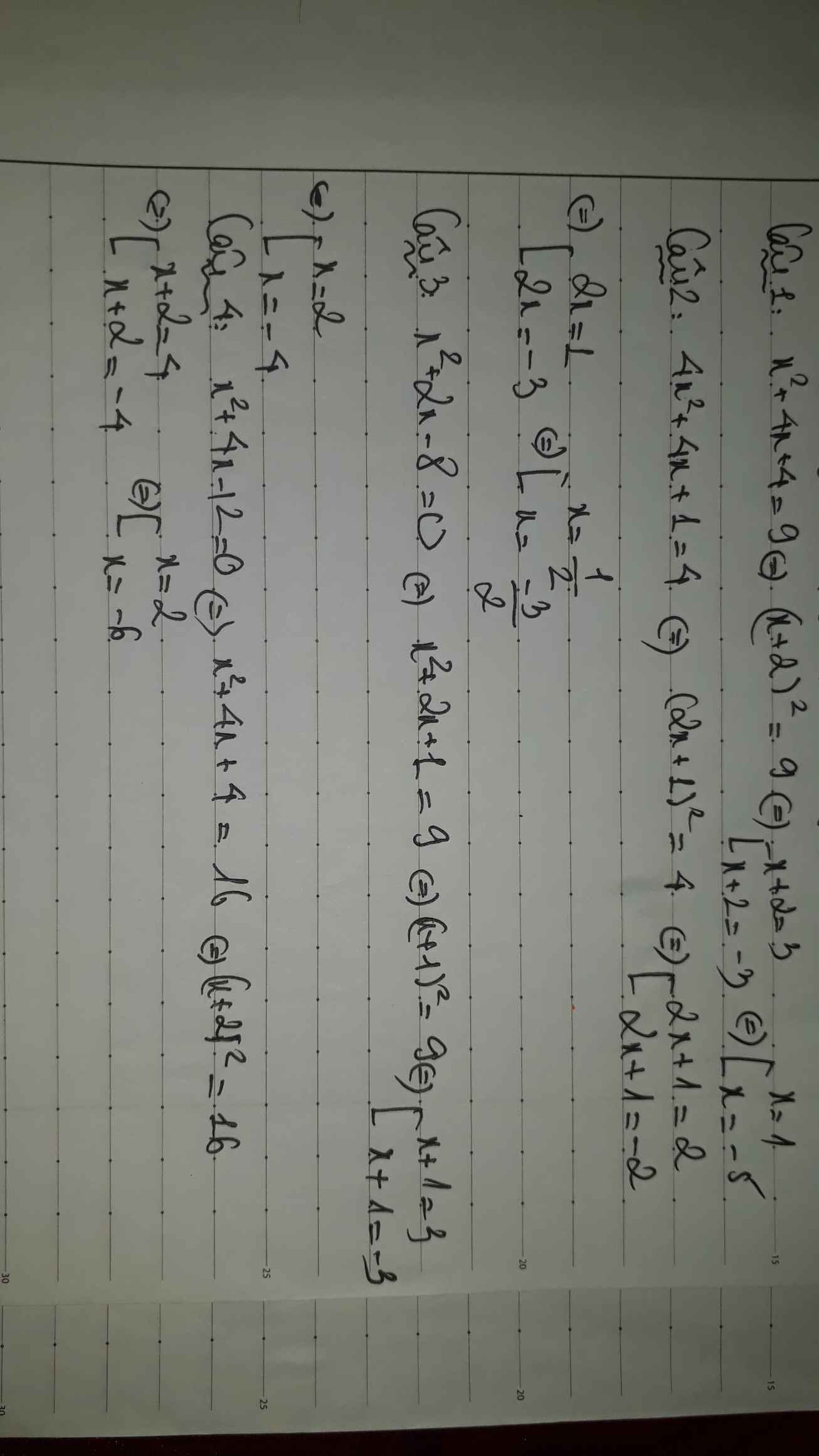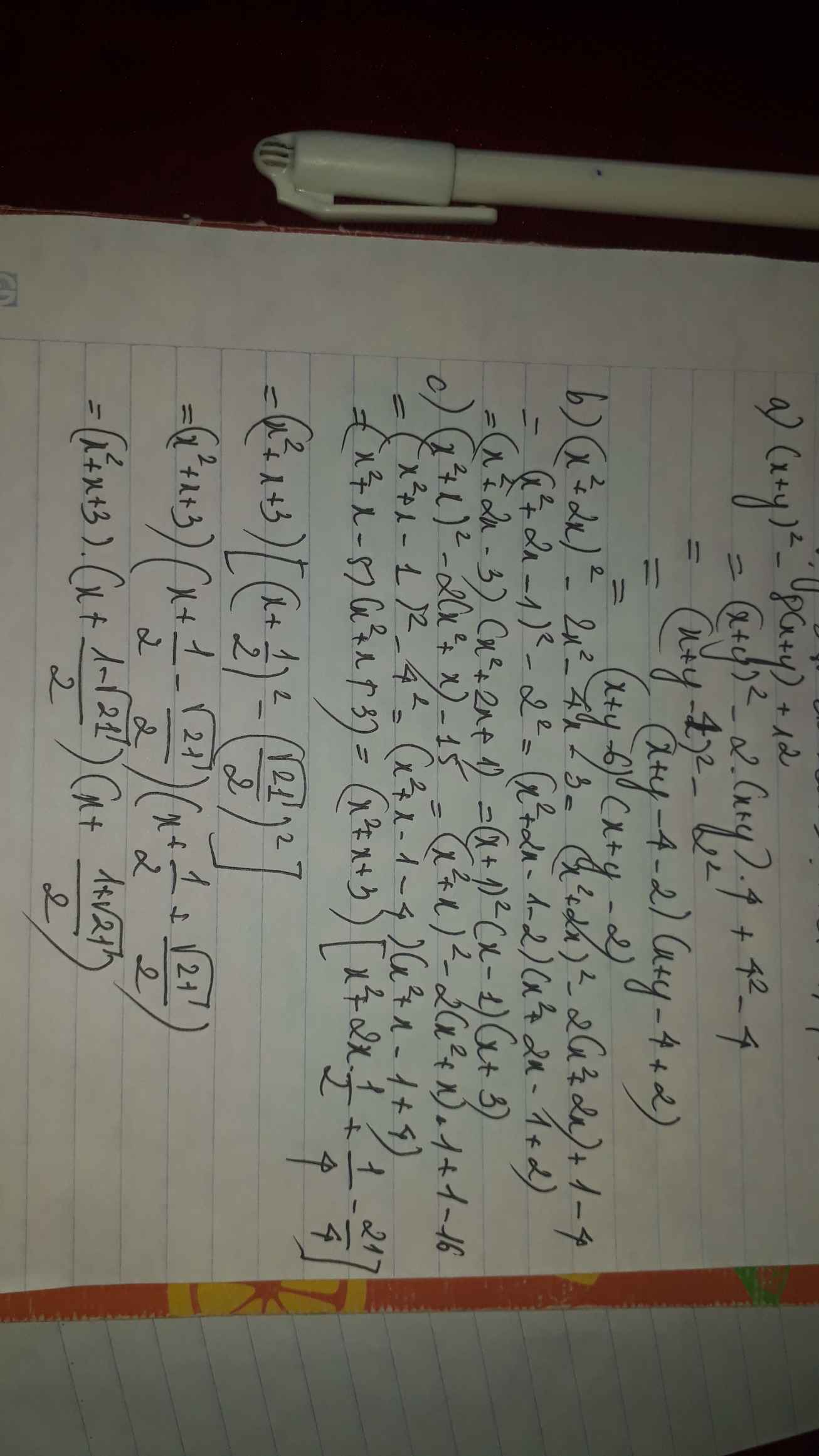(x2−4x)2−8(x2−4x)+15=0

Những câu hỏi liên quan
Cho
(
x
2
–
4
x
)
2
+
8
(
x
2
–
4
x
)
+
15
(
x
2...
Đọc tiếp
Cho ( x 2 – 4 x ) 2 + 8 ( x 2 – 4 x ) + 15 = ( x 2 – 4 x + 5 ) ( x – 1 ) ( x + … ) . Điền vào dấu … số hạng thích hợp
A. -3
B. 3
C. 1
D. -1
Đặt t = x 2 – 4x ta được
t 2 + 8 t + 15 = t 2 + 3 t + 5 t + 15 = t(t + 3) + 5(t + 3) = (t + 5)(t + 3)
= ( x 2 – 4 x + 5 ) ( x 2 – 4 x + 3 ) = ( x 2 – 4 x + 5 ) ( x 2 – 3 x – x + 3 ) = ( x 2 – 4 x + 5 ) ( x ( x – 3 ) – ( x – 3 ) ) = ( x 2 – 4 x + 5 ) ( x – 1 ) ( x – 3 )
Vậy số cần điền là -3
Đáp số cần chọn là: A
Đúng 0
Bình luận (0)
Tim x, biết:
Câu 1. x2 + 4x + 4 = 9
Câu 2. 4x2 + 4x + 1 = 4
Câu 3. x2 + 2x - 8 =0
Câu 4. x2 + 4x - 12 = 0
Tìm x, biết
b) x2 - 2x + 1 = 4
c) x2 - 4x + 4 = 9
d) 4x2 - 4x + 1 = 4
e) x2 - 2x - 8 = 0
f) 9x2 - 6x - 8 = 0
b)x2-2x+1=4
⇔(x-1)2=4
\(\Leftrightarrow\left[{}\begin{matrix}x-1=2\\x-1=-2\end{matrix}\right.\Leftrightarrow\left[{}\begin{matrix}x=3\\x=-1\end{matrix}\right.\)
c)x2-4x+4=9
⇔ (x-2)2=9
\(\Leftrightarrow\left[{}\begin{matrix}x-2=3\\x-2=-3\end{matrix}\right.\Leftrightarrow\left[{}\begin{matrix}x=5\\x=-1\end{matrix}\right.\)
d)4x2-4x+1=4
⇔ (2x-1)2=4
\(\Leftrightarrow\left[{}\begin{matrix}2x-1=4\\2x-1=-4\end{matrix}\right.\Leftrightarrow\left[{}\begin{matrix}x=\dfrac{5}{2}\\x=\dfrac{-3}{2}\end{matrix}\right.\)
e)x2-2x-8=0
⇔ x2-4x+2x-8=0
⇔ x(x-4)+2(x-4)=0
⇔(x-4)(x+2)=0
\(\Leftrightarrow\left[{}\begin{matrix}x=4\\x=-2\end{matrix}\right.\)
f)9x2-6x-8=0
⇔ 9x2-12x+6x-8=0
⇔ 3x(3x-4)+2(3x-4)=0
⇔ (3x-4)(3x+2)=0
\(\Leftrightarrow\left[{}\begin{matrix}x=\dfrac{4}{3}\\x=\dfrac{-2}{3}\end{matrix}\right.\)
Đúng 1
Bình luận (0)
Tìm x biết:a)
x
6
+ 2
x
3
+1 0; b) x(x - 5) 4x - 20;c)
x
4
-2
x
2
8-4
x
2
; d) (
x
3
-
x
2
) - 4
x
2
+ 8x-4 0.
Đọc tiếp
Tìm x biết:
a) x 6 + 2 x 3 +1 = 0; b) x(x - 5) = 4x - 20;
c) x 4 -2 x 2 =8-4 x 2 ; d) ( x 3 - x 2 ) - 4 x 2 + 8x-4 = 0.
a) x = -1. b) x = 4 hoặc x = 5.
c) x = ± 2 . d) x = 1 hoặc x = 2.
Đúng 0
Bình luận (0)
phân tích đa thức thành nhân tử
a) (x+y)2-8(x+y)+12
b) (x2+2x)2-2x2-4x-3
c) (x2+x)2-2(x2+x)-15
a/ \(\left(x+y\right)^2-8\left(x+y\right)+12\)
\(=\left(x+y\right)\left(x+y-8+12\right)\)
\(=\left(x+y\right)\left(x+y+4\right)\)
==========
b/\(\left(x^2+2x\right)^2-2x^2-4x-3\)
\(=\left(x^2+2x\right)^2-\left(2x^2+4x\right)-3\)
\(=\left(x^2+2x\right)^2-2\left(x^2+2x\right)-3\)
\(=\left(x^2+2x\right)\left(x^2+2x-5\right)\)
===========
c/ \(\left(x^2+x\right)^2-2\left(x^2+x\right)-15\)
\(=\left(x^2+x\right)\left(x^2+x-2-15\right)\)
\(=\left(x^2+x\right)\left(x^2+x-17\right)\)
[---]
Đúng 1
Bình luận (0)
Bài 5. Phân tích các đa thức thành nhân tửa) (x2-4x)2-8(x2-4x)+15 b) (x2+2x)2+9x2+18x+20c) ( x+1)(x+2)(x+3)(x+4)-24 d) (x-y+5)2-2(x-y+5)+1Bài 6. Phân tích các đa thức thành nhân tửa) x2y+x2-y-1 b) (x2+x)2+4(x2+x)-12c) (6x+5)2(3x+2)(x+1)-6
Đọc tiếp
Bài 5. Phân tích các đa thức thành nhân tử
a) (x2-4x)2-8(x2-4x)+15 b) (x2+2x)2+9x2+18x+20
c) ( x+1)(x+2)(x+3)(x+4)-24 d) (x-y+5)2-2(x-y+5)+1
Bài 6. Phân tích các đa thức thành nhân tử
a) x2y+x2-y-1 b) (x2+x)2+4(x2+x)-12
c) (6x+5)2(3x+2)(x+1)-6
Bài 2: Tìm x, biết:
a) 4x(x + 1) = 8( x + 1) c) x2 – 6x + 8 = 0
b) x3 + x2 + x + 1 = 0 d) x3 – 7x – 6 = 0
\(a,\Leftrightarrow\left(4x-8\right)\left(x+1\right)=0\\ \Leftrightarrow4\left(x-2\right)\left(x+1\right)=0\Leftrightarrow\left[{}\begin{matrix}x=2\\x=-1\end{matrix}\right.\\ b,\Leftrightarrow\left(x+1\right)\left(x^2+1\right)=0\\ \Leftrightarrow\left[{}\begin{matrix}x=-1\\x^2=-1\left(vô.lí\right)\end{matrix}\right.\Leftrightarrow x=-1\\ c,\Leftrightarrow x^2-2x-4x+8=0\\ \Leftrightarrow\left(x-2\right)\left(x-4\right)=0\Leftrightarrow\left[{}\begin{matrix}x=2\\x=4\end{matrix}\right.\\ d,\Leftrightarrow x^3-3x^2+3x-9x+2x-6=0\\ \Leftrightarrow\left(x-3\right)\left(x^2+3x+2\right)=0\\ \Leftrightarrow\left(x-3\right)\left(x^2+x+2x+2\right)=0\\ \Leftrightarrow\left(x-3\right)\left(x+1\right)\left(x+2\right)=0\\ \Leftrightarrow\left[{}\begin{matrix}x=3\\x=-1\\x=-2\end{matrix}\right.\)
Đúng 1
Bình luận (0)
a) \(\Rightarrow4\left(x+1\right)\left(x-2\right)=0\)
\(\Rightarrow\left[{}\begin{matrix}x=-1\\x=2\end{matrix}\right.\)
b) \(\Rightarrow x^2\left(x+1\right)+\left(x+1\right)=0\)
\(\Rightarrow\left(x+1\right)\left(x^2+1\right)=0\)
\(\Rightarrow x=-1\left(do.x^2+1\ge1>0\right)\)
c) \(\Rightarrow x\left(x-4\right)-2\left(x-4\right)=0\)
\(\Rightarrow\left(x-4\right)\left(x-2\right)=0\)
\(\Rightarrow\left[{}\begin{matrix}x=4\\x=2\end{matrix}\right.\)
d) \(\Rightarrow x^2\left(x-3\right)+3x\left(x-3\right)+2\left(x-3\right)\)
\(\Rightarrow\left(x-3\right)\left(x^2+3x+2\right)=0\)
\(\Rightarrow\left(x-3\right)\left(x+1\right)\left(x+2\right)=0\)
\(\Rightarrow\left[{}\begin{matrix}x=3\\x=-2\\x=-1\end{matrix}\right.\)
Đúng 1
Bình luận (0)
a) A = -3x(x-5) +3( x2 -4x) -3x-10
b) B = 4x( x2 -7x +2) – 4( x3 -7x2 +2x -5)
c) C = 5x( x2 – x) – x2( 5x-5) -15
d) D = 7( x2 -5x+3)- x( 7x-35) -14
e) E = x2 - 4x - x( x-4) -15
A = - 3\(x\).(\(x-5\)) + 3(\(x^2\) - 4\(x\)) - 3\(x\) - 10
A = - 3\(x^2\) + 15\(x\) + 3\(x^2\) - 12\(x\) - 3\(x\) - 10
A = (- 3\(x^2\) + 3\(x^2\)) + (15\(x\) - 12\(x\) - 3\(x\)) - 10
A = 0 + (3\(x-3x\)) - 10
A = 0 - 10
A = - 10
Đúng 0
Bình luận (0)
1) (3x - 2)(4x + 5) = 0
2) (4x + 2)(x2 + 3) = 0
3) (2x + 7)(x - 3)(5x - 1) = 0
4) x2 - 3x = 0
5) x2 - x = 0
1
(3x-2)(4x+5)=0
⇔ 3x-2=0 -> x= 2/3
⇔ 4x-5=0 x= 5/4
Vậy tập nghiệm S = { 2/3; 5/4}
Đúng 1
Bình luận (0)
2, (4x+2)(\(X^2\)+3)=0
⇔ 4x+2=0 -> x= -1/2
\(x^2\)+3=0 -> x= \(\sqrt{3}\); -\(\sqrt{3}\)
Vaayj tập nghiệm S= { -1/2; \(\sqrt{3}\);-\(\sqrt{3}\)}
Đúng 1
Bình luận (0)
3)
(2x+7)(x-3)(5x-1)=0
⇔ 2x+7=0 -> x= -7/2
x-3 =0 -> x = 3
5x-1 =0 -> x= 1/5
Vậy tập nghiệm S={ -7/2; 3; 1/5}
Đúng 1
Bình luận (0)
Xem thêm câu trả lời























